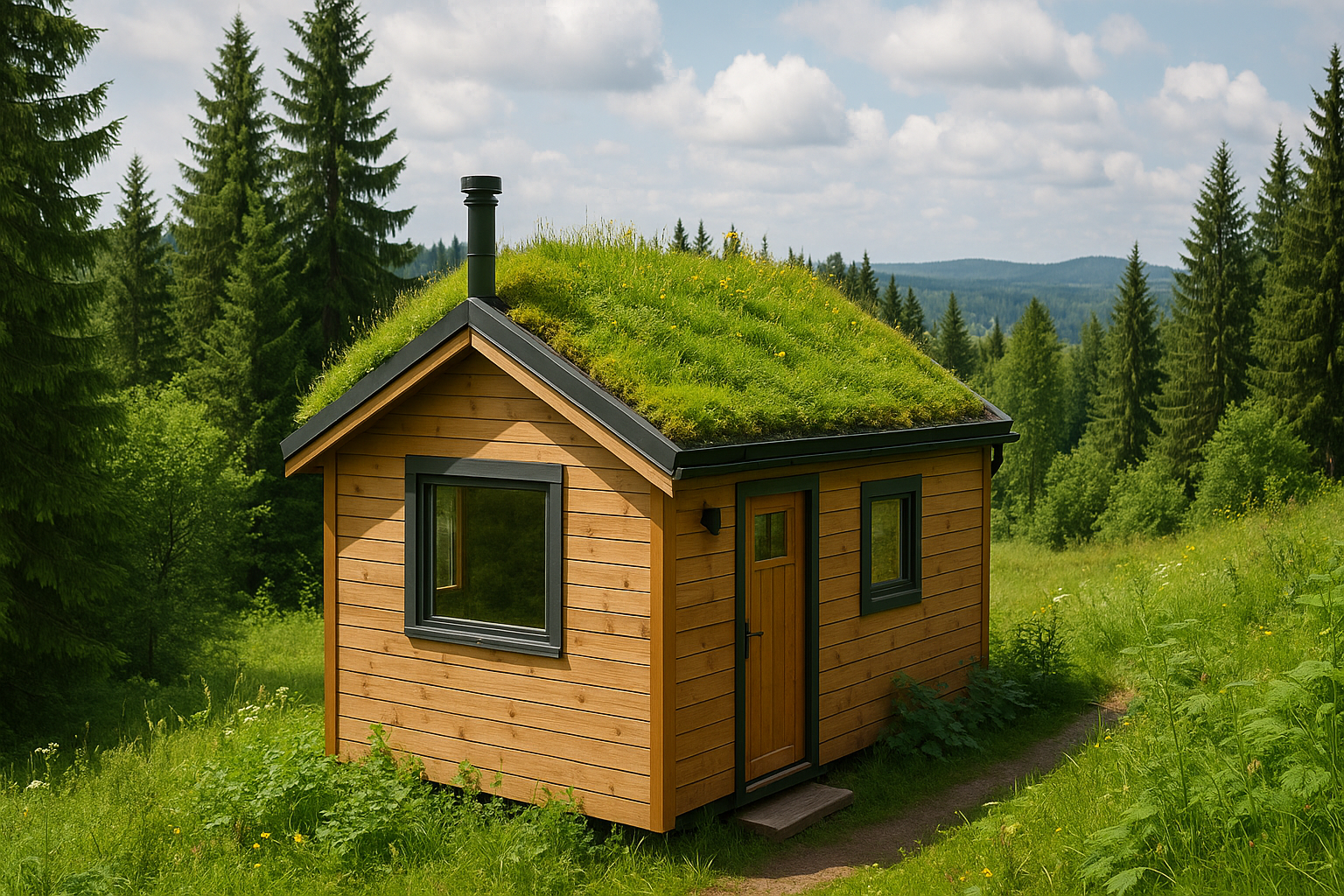
Green Roofs for Tiny Homes: Sustainable Solutions for the Canadian Climate
Estimated reading time: 8 minutes
Key Takeaways
- Green roofs boost energy efficiency and natural insulation, cutting heating and cooling costs.
- They provide effective stormwater management and help reduce urban heat islands.
- Extensive green roofs are ideal for tiny homes due to their lightweight design and low maintenance.
- Proper design, native plant selection, and structural assessments are essential in the harsh Canadian climate.
- Green roofs enhance sustainable living for both tiny homes and eco-friendly ADUs.
Table of contents
Introduction: Green Roofs for Tiny Homes and Tiny Home Sustainability in the Canadian Climate
Green roofs for tiny homes are among the most exciting trends in eco-friendly living, especially for Canadian tiny homeowners. This innovative approach maximizes energy efficiency, improves environmental health, and makes small spaces more livable—even in harsh Canadian winters.
A green roof, also known as a “living roof,” involves layering soil and vegetation over a waterproof membrane. This creates a mini ecosystem that not only supports plant life but also regulates building temperature. According to the Green Roofs for Healthy Cities organization, a green roof “is a system that is intentionally designed to support plant growth and manage water, built over a waterproofing membrane of a man-made structure.”
Across Canada, green roofs are rapidly gaining popularity as homeowners seek to lower utility bills, reduce their environmental footprint, and adapt better to the climate challenges. Research confirms that green roofs address urban issues such as stormwater management, heat islands, and biodiversity loss, all while fitting atop small dwellings (source).
Understanding Green Roofs: Types of Green Roofs and Roof Gardening for Tiny Home Sustainability
Green roofs are far more than merely placing plants on a roof. They are engineered systems built with multiple layers that enable roof gardening and boost the sustainability of tiny homes.
What Makes Up a Green Roof?
- A waterproofing membrane to protect the structure
- A root barrier to prevent damage to the membrane
- A drainage layer to channel excess water away
- A filter layer to keep soil out of the drains
- An engineered growing medium
- Vegetation suitable for the local climate
Types of Green Roofs
Green roofs are primarily categorized into two types (source):
1. Extensive Green Roofs
- Soil depth: 6–20 cm (2.5–8 inches)
- Lightweight—ideal for tiny homes
- Low-maintenance with minimal irrigation
- Planted with hardy groundcovers, sedums, and native grasses
- Suitable for ADUs and small dwellings
2. Intensive Green Roofs
- Soil depth: 20+ cm (8+ inches)
- Heavier and supports larger plants or small trees
- Higher maintenance with frequent care and irrigation needs
- Typically used on large, reinforced buildings
For tiny homes—with limited load capacity—extensive green roofs are the natural choice.
Why Choose Eco-Friendly ADUs and Tiny Homes with Green Roofs?
Eco-friendly ADUs and tiny homes are designed to reduce energy use and minimize waste. Adding a green roof amplifies these benefits by delivering:
- Natural Insulation: Vegetation and soil block harsh summer sun and buffer winter cold. Studies have shown that green roofs can reduce summer cooling needs significantly (source & source).
- Stormwater Management: They absorb and filter rainfall, reducing runoff and protecting waterways (source).
- Urban Heat Island Reduction: Plant covers cool roof surfaces and improve air quality.
- Prolonged Roofing Lifespan: Acting as a shield, green roofs protect the underlying materials from UV rays and temperature swings (source & source).
By choosing green roofs, homeowners can achieve enhanced energy savings and sustainable living while ensuring that their tiny homes or eco-friendly ADUs remain resilient in the face of Canada’s challenging climate.
Considerations for Green Roofs in the Canadian Climate and Roof Gardening
Canadian Climate: Key Challenges
- Extreme Cold and Freeze-Thaw Cycles: Repeated freezing and thawing can damage plants and roofing materials.
- Heavy Snowfall: Snow accumulation adds weight and soaks the growing medium.
- Seasonal Moisture and Drought: Fluctuating conditions call for adaptable drainage and planting strategies.
Solutions for Canadian Green Roofs
- Native and Cold-Hardy Plant Selection: Choose sedums, native grasses, and alpine flowers that thrive even during Canadian winters (source).
- Robust Materials and System Design: Use weatherproof membranes, efficient drainage layers, and snow guards to prevent ice dams.
- Proper Slope and Sun Exposure: Ensure a minimum roof pitch so water runs off and position the roof to receive optimal sunlight.
Step-by-Step Guide to Building a Green Roof on Tiny Homes and ADUs
1. Site Assessment and Structural Considerations for Tiny Home Sustainability and Green Roofs
Before starting, determine if your structure can support the added load from wet soil, mature plants, and snow. Consult a structural engineer experienced with tiny homes or ADUs to assess load-bearing capacity.
2. Selecting the Right Green Roof System for Tiny Homes
For compact dwellings, extensive green roof systems are preferred. Some great options include:
- Modular Tray Systems: Lightweight trays pre-filled with engineered growing medium and plants that snap together for simple assembly and repairs.
- Pre-Planted Mats: Rolled-out like sod for instant coverage and ease of installation.
3. Installation Process for Green Roofs for Tiny Homes
The installation involves:
- Installing Waterproofing and Root Barrier Layers: Create a watertight seal and add a root barrier to protect the membrane.
- Laying Down Drainage and Filter Layers: Ensure that excess water is channeled away safely while preventing soil clogging.
- Spreading Lightweight, Engineered Growing Medium: Use specially formulated soil mixes rich in nutrients but lighter than regular soil.
- Planting Vegetation: Arrange native, diverse species to achieve dense coverage and reduce weed growth (source).
4. Final Touches: Winter-Proofing and Code Compliance
- Install edge restraints or snow guards to secure soil and plants during winter storms.
- Review local building codes and standards to ensure compliance with fire, weight, and stormwater guidelines.
Following these steps helps ensure that your green roof not only looks fantastic but functions safely and efficiently throughout Canada’s changing seasons.
Maintaining Green Roofs for Long-Term Sustainability: Roof Gardening and Tiny Home Reliability
Essential Roof Gardening Maintenance Tasks
- Watering: While established green roofs require little water, young plants or dry spells may need occasional supplemental watering.
- Seasonal Care:
- Spring: Inspect for winter damage, replant bare spots, and clear debris.
- Fall: Remove fallen leaves and weeds, inspect for pests, and check waterproofing layers.
- Winter Preparation: Ensure drains are unclogged before heavy snowfall and check for any structural stress after storms.
Troubleshooting and Preventative Care
- Monitor for leaks inside the structure after heavy rainfalls.
- Replace stressed or dead vegetation promptly.
- Prevent pooling of water by keeping drainage mats and slopes free from blockages.
Regular maintenance ensures your green roof remains effective, safe, and beautiful year after year (source & source).
Case Studies: Green Roofs for Tiny Homes and Eco-Friendly ADUs in Canadian Cities
Toronto: Mandatory Green Roofs and Innovative Projects
Toronto pioneered mandatory green roofs for new large buildings and now incentivizes homeowners and developers. Numerous LEED-certified buildings in Toronto show benefits such as:
- Enhanced insulation reducing heating/cooling costs
- Improved stormwater control minimizing urban flooding
- Urban cooling and better air quality
Homeowners in Toronto and Ottawa report year-round comfort, reduced bills, and fewer structural repairs (source).
Ottawa and Beyond
Across Ottawa and other major cities, compact homes and ADUs with green roofs have shown:
- Lush, low-maintenance rooftop landscapes
- Resilience through harsh winters and hot summers
- Effective stormwater absorption and increased biodiversity
For more details, refer to recent field studies (source & source).
Conclusion: Green Roofs for Tiny Homes Enable Tiny Home Sustainability and Eco-Friendly ADUs in Canada
Green roofs for tiny homes are not just a trend—they represent a smart solution for achieving sustainable, energy-efficient, and comfortable living in Canada. Whether building a new ADU, retrofitting an existing cabin, or enhancing an urban laneway suite, a green roof offers:
- Enhanced insulation and energy savings year-round
- Reliable stormwater management and reduced runoff
- A cleaner, cooler, and healthier living environment
- Extended longevity of roofing materials
Adopting green roofs and sustainable roof gardening practices provides substantial environmental and economic benefits. Explore more about sustainable living and energy efficiency to make an informed decision for your future home.
Next Steps:
- Research local green roof codes: Check municipal requirements and incentive programs.
- Consult experts: Collaborate with structural engineers and green roof specialists for secure installation.
- Choose native plants: Opt for species that thrive under local conditions for lasting, low-maintenance coverage.
Frequently Asked Questions
Q1: What exactly is a green roof?
A green roof is a multi-layered system that integrates a waterproof membrane, drainage, growing medium, and vegetation to create a living, functional rooftop ecosystem.
Q2: Are extensive green roofs suitable for tiny homes?
Yes, extensive green roofs are ideal for tiny homes due to their lightweight design, modular installation, and low maintenance requirements.
Q3: How do green roofs perform in harsh Canadian winters?
Green roofs, when designed with robust materials, proper drainage, and cold-hardy native plants, are well-equipped to handle extreme cold, heavy snowfall, and freeze-thaw cycles.

Leave a Reply